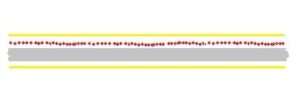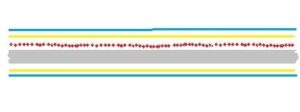Structures of underpads
The company’s products:
Structures of absorbent disposable underpads of MEDMIL LLC:
Absorbent disposable underpads, produced by our company, are rectangular multilayer products, the layers of which are bonded by a hot-glue method (by spraying hot melted glue with subsequent rolling through a system of hot stamping shafts).
The top of the underpad is covered with a nonwoven hydrophilic material that easily allows liquid to pass through. The inner (middle) layer – the absorbent underpad core – consists of layers of special tissue paper and fluff pulp, with possible special additives. The lower layer of the underpad – which protects against liquid leakage – consists of a PE film or other waterproof materials.
Depending on the purpose and brand of the product, we use different types of structures, different densities of materials and types of additives. The products differ in weight, size parameters, and specific density. The main variants of the structures of our underpads and the differences in their production technology are listed below:
- Four-layer underpads: this design resembles 3-layer underpads from other manufacturers, fluff pulp is not covered with a second layer of sanitary tissue paper on top, the embossing is not distinct. Underpads of this type are usually somewhat softer to the touch. In such a design, polymer additives are not used, since there is no upper layer of paper fixing them.
Composition: 1. Coating layer: hydrophilic nonwoven material. 2. Absorbent layer: fluff pulp. 3. Supporting layer: sanitary-hygienic tissue paper, on which pulp is laid out. 4. The lower layer that protects against leakage: PE film.
Scheme of 4-layer products:
1. Coating layer: nonwoven material
2. Absorbent layer: fluff pulp
3. Supporting layer: sanitary tissue paper.
4. Protective layer: PE film
- Five-layer underpads: in the absorbent layer, the fluff pulp is covered with sanitary tissue paper on top and bottom, like a sandwich. This is the main type of underpads produced by our equipment. This design increases the uniformity of the canvas, allows to apply a deep, persistent embossing, which increases the strength of the absorbent layer, and the diamond-shaped grooves ensure rapid distribution of the liquid.
Composition: 1. Coating layer: hydrophilic nonwoven material. 2. Covering (distributing) layer of tissue paper. 3. Absorbent layer: fluff pulp. 4. Supporting layer: sanitary-hygienic tissue paper, on which pulp is laid out. 5. The lower layer that protects against leakage: PE film.
Scheme of 5-layer products:
1. Upper coating layer: nonwoven material
2. Covering (distributing) layer of sanitary tissue paper
3. Absorbent layer: fluff pulp
4. Supporting layer: sanitary tissue paper
5. Protective layer: PE film
- Six-layer underpads: structurally similar to 5-layer underpads, but a layer of super absorbing polymer (SAP) powder is added to the base of the absorbent layer – fluff pulp.
Composition: 1. Coating layer – hydrophilic nonwoven material. 2. Covering layer of tissue paper. 3. Layer of powder (granules) of a super absorbing polymer (SAP). 4. Absorbent layer – fluff pulp. 5. Supporting layer: sanitary-hygienic tissue paper, on which pulp is laid out. 6. The lower layer that protects against leakage – PE film.
The structure of this underpad involves dense rolling – stamping of the canvas of the absorbent layers (2,3,4,5 layers) with the application of a permanent diamond-shaped pattern: the pattern grooves ensure rapid liquid distribution.
Scheme of 6-layer products:
1. Coating layer: nonwoven material
2. Covering layer of sanitary tissue paper
3. Layer of small crystals of super absorbing polymer (SAP)
4. Fluff pulp
5. Supporting layer: sanitary tissue paper
6. Protective layer: PE film
- Ultrathin underpads: these are, as a rule, 6-layer underpads, in the manufacture of which an additional reinforced rolling and embossing of the canvas in hot shafts is used, which makes them very dense and compact, but the absorbent properties of the underpad do not decrease. The amount of pulp in these models is usually reduced, as it begins to play a secondary role: a distributing and binding layer for powerful super absorbing polymers that take on the main work of liquid absorption.
Scheme of ultrathin products:
1. Coating layer – nonwoven material
2. Covering layer of sanitary tissue paper
3. Layer of small crystals of super absorbing polymer (SAP)
4. Distribution layer: fluff pulp (optional)
5. Supporting layer: sanitary tissue paper
6. Protective layer: PE film
Scheme of ultrathin products with baking soda or any other component:
1. Coating layer – nonwoven material
2. Covering layer of sanitary tissue paper
3. Layer of small crystals of super absorbing polymer (SAP)
4. Distribution layer: fluff pulp (optional)
5. Layer of small crystals of baking soda or any other add
6. Supporting layer: sanitary tissue paper
7. Protective layer: PE film
- Pulp-free underpads: this is a further promising development of ultra-thin structures, in the manufacture of which only powerful super absorbing polymers, structured in the form of fibers and granules, which take on the entire function of the absorbent layer, are packed inside the “sandwich” of layers of sanitary tissue paper. The lower supporting layer can be made of nonwoven material for a more reliable fixation of the polymer grain layer, when laying, polymer “activation” technologies are used to create a more stable layer.
Scheme of pulp-free products:
1. Coating layer: nonwoven material
2. Covering layer of sanitary tissue paper
3. Absorbing layer – granular super absorbing polymers (SAP)
4. Supporting layer: sanitary tissue paper or nonwoven material.
6. Protective layer: PE film
- Reinforced underpads: special underpads and mats of 5 or 6-layer construction, in the manufacture of which reinforced dense nonwoven materials are used for the coating layer, for the protective layer – a dense PE film or various laminates. This structure allows to provide the mat with necessary rigidity and strength, makes it non-slip, for example, when under the feet of the car driver (Avtomil), or does not allow the animal to damage the coating (Petmil WC Black).
The scheme of reinforced products is shown in the figure:

1. Reinforced coating layer: nonwoven materials of increased density.
2. Covering layer of sanitary tissue paper
3. Super absorbing polymer (SAP)
4. Fluff pulp
5. Supporting layer: sanitary tissue paper
6. Reinforced protective layer: thick PE film or nonwoven material,
laminated from the inside with PE film
- Absorbent elements for special products: the company’s equipment allows to produce absorbent elements of various types for use in special hygienic, household and industrial products.
Schemes of layers of absorbent elements:

Option A:
1. Upper layer – sanitary tissue paper
2. Absorbent core – fluff pulp and SAP powder
3. Bottom layer – sanitary tissue paper 
Option B:
1. Coating layer – nonwoven material.
2. Supporting layer – sanitary tissue paper
3. Absorbent core – fluff pulp and SAP powder
4. Supporting layer – sanitary tissue paper
5. Coating layer – nonwoven material.
 medmill@medmill.ru
medmill@medmill.ru +7 (929) 680-1766
+7 (929) 680-1766